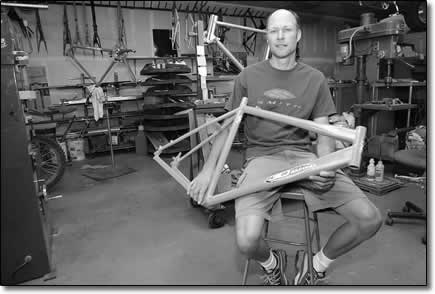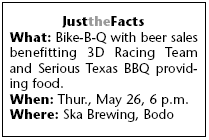|
|
||||||
|
Dedication, Design & Development SideStory: 3D Mountain Bike Team continues climb to top
by Amy Maestas t about the same time the world was foretasting the legacy of a cancer-surviving-Texan’s comeback to the sport of cycling, a Durango cyclist was, in his own right, helping revolutionize the craft of that very sport. That was six years ago. Lance Armstrong, arguably one of cycling’s most remarkable athletes, was across the English Channel winning his first Tour de France. And in Durango, Chris Herting, already a bike builder for 14 years, was introducing a spanking-new material to cyclists in the never-ending pursuit for a light and durable steed. You could say that, quite literally, Herting (along with Doug Bradbury, frame builder for Tomac Cycles) was conducting a bit of rocket science. After all, he had realized that the material the aerospace industry used to make jet fighters could also be used for bike frames and components. Not only was Herting finding out that an aluminum alloy called scandium (discovered in Scandinavia) could create a bike that was 10 percent lighter and nearly 40 percent stronger than traditional materials like steel, he was securing himself a place in the fickle bicycling market. The list of clichés describing Herting’s hand-built custom frames is about as long as one of his legs. In fact, the lanky 6-foot-4-inch-cyclist’s legs somewhat swayed his decision to start building bike frames 20 years ago, with mass-produced bikes only going so far in serving Joe Bikers’ varying body designs and cycling abilities. The native Californian’s lifelong attraction to anything two-wheeled prompted him to fiddle around in his garage in search of a solution. In 1985, Herting joined John Parker in launching Yeti Cycles. Six years later, the duo left the West Coast and set up shop in Durango. Here, Herting honed his welding and geometry and after a year, left Yeti to re-open his one-man business – 3D Racing. At the time, Yeti, which has since moved shop to the Front Range, was what Herting describes as a small- to medium-sized bike company that mass-pro duced conventional bikes. Herting wanted to bust into a market that was more profitable and more challenging. “I’d rather be able to build one bike at a time and develop a relationship with a buyer rather than not know who was buying the bike,” Herting explains while working in his studio shop on Florida Mesa. His quest has been successful. Since 1992, when he seriously started building custom road and mountain bike frames, Herting has been able to pick and choose his customers, materials and designs. For buyers, it translates to only a lucky few – very few – who ride one of Herting’s frames. He estimates that he builds between 170 and 190 frames each year, with some work recently being done on spec for teams of major cycling manufacturers such as Trek, GT, Mongoose and Schwinn. And because of his decades of experience with and connections to metal makers, specifically Easton, Herting is able to be on the cusp of cutting-edge discoveries – like scandium – and more easily get his hands on the goods. Herting builds frames that are, if not spot on, within mere millimeters of a perfect fit for the buyer. The process can be long and involved. It often means Herting and the buyer go back and forth on the design and measurements simply so he can be meticulous. “Anyone can come up with a concept for a bike. It’s the design that is complicated and expensive,” says Herting. Cost for such a specially designed bike runs the scale of thousands of dollars, depending on the demands and various other components. But without any snobbery, Herting believes it weeds out the cyclists who are dreamers and droolers and who don’t always necessarily need a racing-quality ride. To be that discerning allows him to spend more time honing his sophisticated skills with carbon fiber, aluminum and steel, the three types of tubing he uses.
Cost for such a specially designed bike runs the scale of thousands of dollars, depending on the demands and various other components. But without any snobbery, Herting believes it weeds out the cyclists who are dreamers and droolers and who don’t always necessarily need a racing-quality ride. To be that discerning allows him to spend more time honing his sophisticated skills with carbon fiber, aluminum and steel, the three types of tubing he uses. “Having only me do the work means that when I leave the shop at night, I know nothing is getting done wrong. Plus, I don’t want to turn people away because I don’t have time. I don’t want this to be a job.” The quest for exactness means Herting plans to always keep 3D Racing (the Ds stand for dedication, design and development) a one-man company. To date, Herting relies mostly on word of mouth to get business. Only a few years ago did he finally create a website on the Internet to let people know about his company. “Word of mouth is more constant, and it’s more real. I didn’t want to spend all day sitting here answering the phone and returning e-mails to people who weren’t truly interested in getting a custom-built frame,” he says. Earlier this year, Herting got a taste of publicity when Bicycling Magazine reviewed – and raved – about a couple of his frames and his building business. Last year, Herting explains, he tracked4 only 12,000 people visiting his website. After the magazine spot hit the stand in February, he tracked nearly 20,000 people visiting his website during that month alone. “I was overwhelmed by that. But again, I can always work for those who really know what they want and need. During that time, I got about 150 serious e-mail inquiries. From that I have sold 15 bikes.” That level of business works well for Herting right now, because he’s curious to see how, if at all, Armstrong’s retirement from the sport affects the cycling industry – both in participation and in sales. As a small business, the trends affect him in different ways. The increase in popularity of road biking in the past two years, which many attribute to the Tour de France champion, translated to Herting building more road frames than mountain bikes frames. Custom road frames once were only 10 percent of his sales; now they’re 40 percent. But while that’s been happening at 3D, Herting says the overall cycling industry since 2002 has suffered slight declines in sales. The more business he has, he adds, the more he becomes integrated in the trends of the larger industry. “It certainly has a trickle-down effect,” he says. “It will be interesting to see what that effect will be when Lance retires. It could affect my business; I may feel it on a smaller scale.” Until then, Herting isn’t being consumed by anxiety. He’s comfortable having his niche of custom-built frames that appeal to those who know the difference. Everyone is different enough, he says, that customizing bikes provides the creative edge he craves. Besides, he’s got the upper hand on getting himself out of a rut with an option the rest of us don’t have. “If I ever get bored with something, I just make a new bike for myself.” •
|




